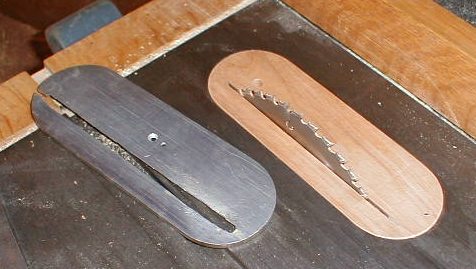

- #OLD CRAFTSMAN TABLE SAW DADO THROAT PLATE HOW TO#
- #OLD CRAFTSMAN TABLE SAW DADO THROAT PLATE INSTALL#
- #OLD CRAFTSMAN TABLE SAW DADO THROAT PLATE FULL#
- #OLD CRAFTSMAN TABLE SAW DADO THROAT PLATE FREE#
To start the motor, I had to flick the blade into motion with a stick. The handle for tightening the rip fence had broken off and other handles were loose. It had been falling apart slowly for years. To do that, I use a simple crosscut sled.On October 21, 2019, my 25-year-old Craftsman table saw died. You have to extend that slot behind the blade in order to accommodate the splitter assembly for the saws guard or a riving knife like this. If you’re going to use your throat plate for a standard blade, there’s still one more step you have to do. Now, if you were going to use this new throat plate for a dado set like this, you’d be done as soon as you cut the slot for the wide blade.
#OLD CRAFTSMAN TABLE SAW DADO THROAT PLATE FULL#
Then switch to your standard saw blade, then repeat the process to cut the kerf slot to full length. An inch or so of height should be all you need. Now, start the saw and slowly crank the blade up through the throat plate. Position the fence close to the blade, but be sure it won’t cut into the fence. Now, set the throat plate in place and slide the rip fence over it to hold it down for the cutting step.
#OLD CRAFTSMAN TABLE SAW DADO THROAT PLATE INSTALL#
Install the dado blade and lower it as far as it will go. Use the outer blade of an 8-inch dado set instead. That’s because some saws don’t allow you to drop the blade down low enough to get the clearance you need. If you’re going to use this throat plate with your standard blade, you may have a problem getting it to fit over the blade in order to make that first kerf cut. The tabs on my saw are too wide for a rabbeting bit, so I’m going to use a straight bit instead, and trim the waste off of my throat plate with it standing on edge against the router table fence. Just raise the bit to meet your depth of cut and route all the way around the plate. If the tabs on your table saw’s throat plate opening are a half-inch wide or less, you can use a rabbeting bit like this to trim away the waste because most rabbeting bits will cut to a half-an-inch wide. This is the amount I need to remove, and I’m going to do that over at the router table. To do that, I’m going to flip the new plate upside down and set it into position, and then trace all around the plate with my pencil. Now, my new throat plate is still thicker than the original, so I need to trim off some of this material on the bottom face so that it will sit flush in my table saw’s opening. Then drill a hole through your new throat plate to make it easier to get in and out of the saw. If yours does, too, sand the edges slightly to improve the fit. Now, separate the two and clean off the tape, and see if your new throat plate fits the opening. Feed the two counterclockwise against the bit to make the cut. Now, raise the router bit so the guide bearing will roll along the edge of the master throat plate and route away the extra waste. Press the two together to make sure they’re firmly adhered. To do that, use a few strips of double-sided carpet tape to stick the face of your master throat plate down to your blank. You can trim off the rest of this waste using a bearing-guided flush trim bit and your master throat plate as a template. Either way, cut just outside your layout line by about 1/16 to 1/8 of an inch. Now, trace the throat plate’s shape onto the blank and cut it out at a band saw or with the jigsaw. Start by cutting a blank that’s a little larger than your master throat plate all around. I’m going to use this piece of 3/4-inch Baltic birch plywood. I think the easiest way to make them is to start with something that’s the same thickness as the depth of your saw’s throat plate opening down to these tabs that support it, or start with something that’s overly thick to begin with, because you can always trim it down on the back side to get a flush fit. Good quality plywood, ordinary MDF, or even a piece of stable hardwood like this poplar will work fine, too. It’s a slick, hard synthetic material that will last for a long time. Rockler sells throat plate blanks made a phenolic. You can make throat plates from a variety of different materials, but you want them to be strong, flat, and easy to cut.
#OLD CRAFTSMAN TABLE SAW DADO THROAT PLATE HOW TO#
In this video, I’m going to show you how to make one. Speaker: Zero-clearance throat plates are easy to make for table saws with common, oval-shaped throat plates like this. Video: How To Make Zero Clearance Throat Plate Inserts For Table Saws - Video Transcript
#OLD CRAFTSMAN TABLE SAW DADO THROAT PLATE FREE#


 0 kommentar(er)
0 kommentar(er)
